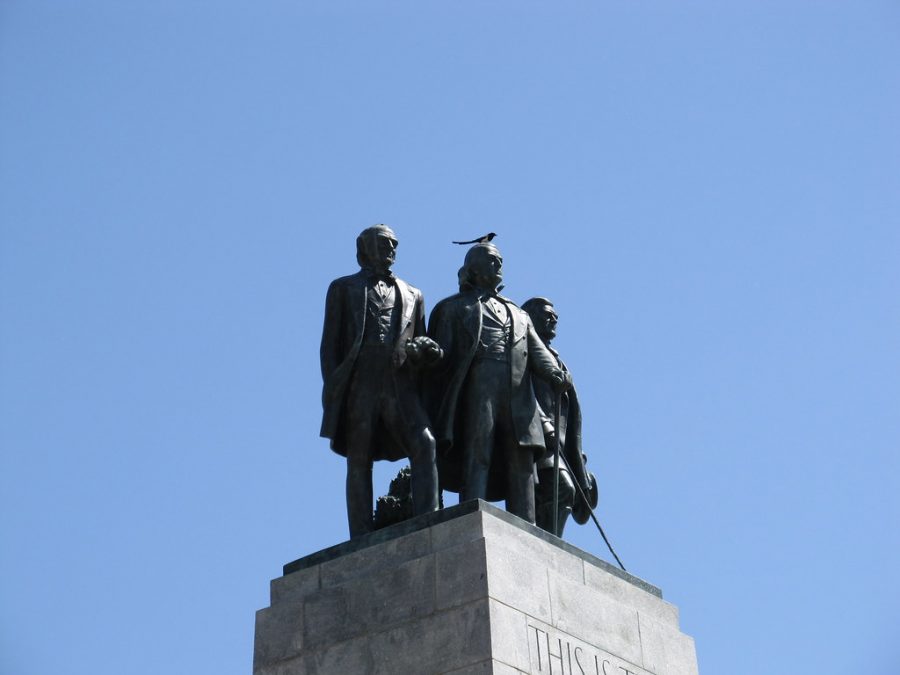Burton: Memorials Have Complicated Histories – Don’t Jump the Gun Determining Their Fate
August 26, 2020
Following the egregious and tragic killing of George Floyd, protests throughout the world have sparked critical dialogues not only on police reform, racial income disparities and other contemporary inequities, but also on historical perspectives. More and more young people are becoming aware of human rights violations against marginalized groups, especially Black Americans. For example, the New York Times’ controversial “1619 Project” — a series of essays about the influence of African enslavement during the founding of the United States — has given insight to many Americans on our dark past. With these new perspectives, people worldwide are now questioning the validity of certain statues and monuments. In the US, controversy is especially centered around Confederate statues. Some protestors have even torn down statues of Christopher Columbus and Confederate president Jefferson Davis, among other historical figures. While it’s productive to reexamine the lives of historical figures and how and whether we choose to commemorate them, the inherent moral complexities of history mean that serious dialogue should take place before action is taken on statues and monuments.
The Inevitability of Simplification
We build monuments to celebrate and remember notable figures or events in history. They honor bravery, ingenuity, creativity and, sometimes, the tragedy of history. However, this seemingly positive purpose introduces the problem of simplification.
It is natural to want to be portrayed in a positive or unambiguous light. We would all like to be remembered for our best traits and accomplishments, and monuments are very much the same way. In other words, memorials and statues tend to cast historical figures or events in black and white, when in reality, they are much grayer. For example, a memorial of President Franklin D. Roosevelt will likely commemorate his leadership during the Great Depression and World War II but will omit or bring less attention to his role in interning thousands of Japanese Americans. Monuments tend to not be nuanced, in other words. They don’t provide a deep analysis of history, but rather a digestible narrative.
Difficult Tradeoffs
There are many historical figures who accomplished great things but who also upheld and advocated for terrible causes or institutions such as African enslavement, misogyny and anti-Semitism. Monuments often do not portray these complicated and contradictory actions effectively. Communities then have to determine whether these actions warrant a memorial to stay or be torn down. Imagine a statue in Washington D.C. commemorating Woodrow Wilson. Wilson was a well-known racist and staunch advocate of segregation, but his accomplishments include the relatively progressive — though unsuccessful — foreign policy of 14 points and domestic policies that protected labor unions and consumers. Given all this, is Wilson still worth keeping up as a statue? Was Wilson a good man who did some horrible things, or a horrible man who did some good things? The answer to that question is difficult when you consider his history from multiple angles. Princeton University faced a similar situation. Princeton’s School of Public and International Affairs was formerly named after Woodrow Wilson, but the name was recently removed after university leaders determined that Wilson’s name was “inappropriate” for a public policy school. This is a fair and reasonable decision, but a difficult one that was, wisely, not made hastily.
Removal Should Be a Formal Community Decision
Since the George Floyd protests, many statues of historical figures have been taken down — Wikipedia even has a well-curated page on the subject. Many of these removals were conducted after deliberation from communities or local boards. However, a sizable minority of these statues were removed forcibly by protestors. Since protests are often impassioned and exciting, a statue may be removed before considering a figure’s past. An example of this happened in Madison, Wisconsin, where the statue of Hans Christian Heg, a Union soldier and abolitionist during the Civil War, was removed. His statue was removed around same the time as statues tied to Columbus and the Confederacy, and Heg’s statue was taken down due to its proximity to the state capitol building. Monuments and statues are oftentimes the property of a city or neighborhood, and they represent — or are supposed to — the values of a particular place. Ultimately, the choice to take a memorial down should be the decision of those who live in the respective neighborhood.
The events catalyzed by George Floyd’s unjust death have spurred a global discussion on institutions and their racial wrongdoings. Memorials and statues are in the crosshairs of the dialogue. But history is complicated — so they shouldn’t be taken down in haste, but rather after deliberation and discussion with the community in mind.








